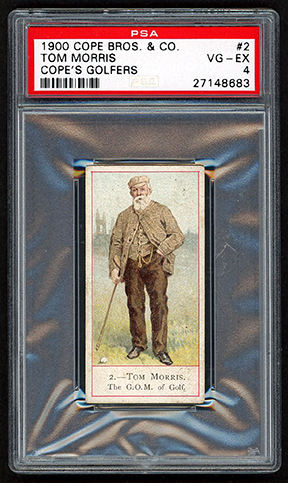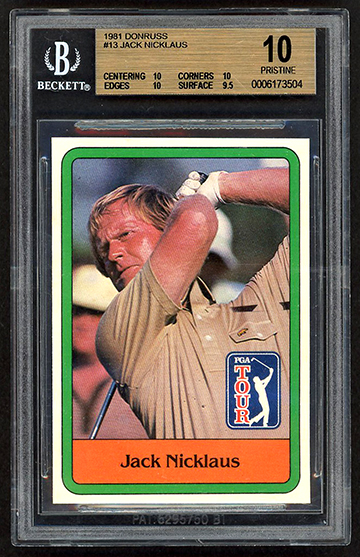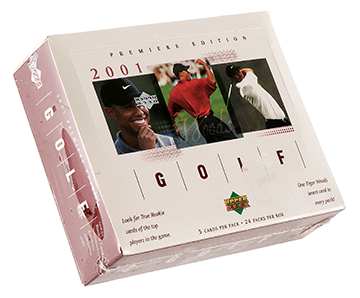Collecting Golf Cards
By George Petro
The golf collecting world is abuzz with regards to early 2023 auction results for encapsulated or “slabbed” cards, photos and tickets that have been examined by experts and then sealed in tamper resistant plastic cases, labeled for condition (Grade 1-10) or as “Authentic”, and assigned a cataloged unique serial number. Slabbing usually increases the value of an item and often significantly so, but occasionally (especially for lessor cards) if a slabbed card is given a low grade, it can be less desirable than the “raw” card. A signed item can be graded for the signature alone, so when purchasing, be careful to discern if it’s only the signature that’s received a high grade on a potentially inferior card.
The various authentication or grading agencies include: PSA – Professional Sports Authenticators; BGS – Beckett Grading Services; SGC – Sportscard Guaranty Corporation; and others. Note that BCCG – Beckett Collector’s Club Grading may use lower standards so expect to pay less for those items. JSA- James Spence Authentications does authenticate items and signatures but doesn’t do encapsulations at this time.

Players cards can be printed by multiple companies in multiple years and most often in large quantities so the vast majority are “commons” with limited value. Typically, for any given player the most desirable card is their “Rookie Card”. It might not be the first year they played at a top level, but is rather their first appearance on a card “usually” within a recognized set of cards (though sometimes there are debates – hence Tiger Woods has multiple different rookie cards produced a full five years apart. Of course, a rookie card by a lesser player is unlikely to be worth much, though correctly speculating who might become the next superstar is both fun and has considerable upside potential, as can procuring the cards of past golfing champions which may have been under-appreciated as collectible as well as slabbing old cards and photographs that you have sitting in a drawer.
Golf cards first appeared in the late 19th century with many related to tobacco, other products or promotions. Some collectors assemble complete sets so commons, even in lessor condition, can serve as placeholders or be the only option depending on one’s budget. And some collectors just have an appreciation for a particular player regardless of status. In any given universe of cards, rarity is defined more by condition than actual production numbers, even within limited editions. Cards fresh out of sealed boxes or from unopened single packs often have disappointing grades. Once the grader confirms that the card is authentic AND not maliciously altered (such as trimming to hide damaged edges requiring precise measurements by made by the grader, or detecting bleaching or touch ups), it is evaluated for Centering of the image, Corners, Edge sharpness, and Surface quality (focus/gloss/wear/stains/marks/etc.).
If you aren’t sure if a card is in demand, visit the website of a grading company and review their database of graded items. Cards are cataloged by card series or player name, telling you what card(s) is the rookie and how many total cards they have graded and how many at each level (the population or POP) as well as the approximate current values. A vintage card, even if popular, may have few of its remaining examples submitted and scant few of those might grade high because of their age, making even a 7 or 8 grade the best known and expensive. Cards in very low demand will have few cards submitted and therefore even a 10 with a POP of 1 (the best and only such grade known) might still have insignificant value. On the other hand, even a high production modern card of a top player might have huge numbers of submissions with most in excellent condition, so among them there are virtually no 5’s or 6’s with the majority rating 9, and with many 10’s. If demand is high those numerous 10’s will have significant value that quickly decreases for a 9. If there are any signed cards they are recorded in the database as well.
To submit a card, ticket or photo by mail, these “third party” companies provide directions and charging options. Pricing varies with turnaround time and the predicted value of your card (where they may provide a “Financial Guaranty of Grade & Authenticity”, a sizable charge for more expensive cards in case there is a dispute between subsequent owners).
For PSA, a single card is $25 plus shipping returned in 20 business days; $75 for a card worth up to $1,500 within 10 days, $300 for cards up to $5,000 within three days and so on. If you underestimate the grade/expected value you may be subjected to an upcharge. Graders claim the charge has nothing to do with the grade the card will be given. Some submitters intentionally choose a lower payment tier hoping they won’t be up charged while others hope that selecting a higher charge might gain them a better grade if the card is between grades. Many complain about higher charges for more expensive cards since their grading (usually) requires no extra effort and they are not reimbursed if the card grades low and they have overvalued it.

For an additional fee they will grade both the item and any added signature. Items can also be “reholdered” if their cases have been damaged at $25 if valued at less than $5,000 ($500 for a card worth $500,000). Also for an extra charge, BGS will report each “subgrade” separately as well as the overall grade on the label. If every sub garners a 10, a “Black” grading label is provided in the case. Beckett has a 9.5 rating for cards that fall just short of the black label. Of late, PSA has been considered the “King” of grading services with SGC on its heels and BGS trying to retain its former position amongst the big three. Generally, PSA brings the highest prices for equal grading numbers, but things evolve quickly.
If you’re collecting/buying cards, you might separate valuable ones from individual packs or sealed boxes, but even if you know what series contain popular cards, statistically you’d need to open a lot of them to score a rarer one in top condition, so making a profit by buying multiple boxes is unlikely and expensive, aside from the excitement in doing so. Often, it’s better to buy a “raw” card for your collection and submit it if you think it might grade high. Some “crack” cases of cards they suspect have been under-graded by lessor companies and resubmit them (often to PSA). Also, look for any signs of tampering such as “frosting” of the transparent edges of plastic cases where the case has been cracked and possibly a card of a lower grade or a counterfeit label is substituted.

